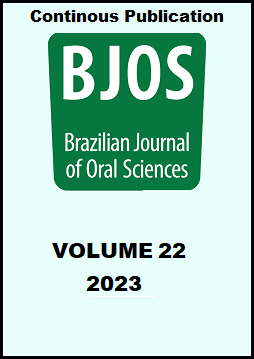Abstract
The objective of this study was to evaluate the effect of abrasion wear on surface roughness and microhardness of different commercially available resin composites simulating pH-challenges of the oral cavity. Methods: Three resin composites (RC) were used in this study: one conventional: Z250; and two bulk fill resin composites (BRC): Tetric N-Ceram (TNC) and Sonic Fill (SF). The RC was inserted in a prefabricated mold (15mm wide x 4mm thickness) in two layers, or in a single layer for BRC. Thirty samples were prepared and surface roughness (Ra) and Knoop microhardness (KHN) test were performed at three different time-points of evaluation: baseline (24h after sample preparation); partial (after pH cycling); and final (after simulated toothbrushing procedure). Two samples of each group were selected after different treatments and analyzed descriptively on a scanning electron microscopy (SEM). Data from Ra and KHN were analyzed by two-way repeated-measures ANOVA and Bonferroni’s post-hoc test with a significance level set at 5%. Results: Ra increased for all groups (p<0.001), at the final time-point, Z250 and TNC groups present the highest values. Oppositely, KHN decreased for all groups (p<0.001), Z250 group showed the highest KHN values for all time-points (p<0.001). The SEM imagens showed a regular surface for samples cycled and irregular with inorganic particles exposed for samples toothbrushed. Conclusion: pH-cycling and simulated toothbrushing affected the superficial properties (roughness and Knoop microhardness), as observed at SEM imagens, with irregular surface with inorganic particles exposure.
References
Chesterman J, Jowett A, Gallacher A, Nixon P. Bulk-fill resin-based composite restorative materials: a review. Br Dent J. 2017 Mar;222(5):337-44. doi: 10.1038/sj.bdj.2017.214.
Asadian F, Shahidi Z, Moradi Z. Evaluation of wear properties of four bulk-fill composites: attrition, erosion, and abrasion. Biomed Res Int. 2021 Nov;2021:8649616. doi: 10.1155/2021/8649616.
Lins RBE, Aristilde S, Osório JH, Cordeiro CMB, Yanikian CRF, Bicalho AA, et al. Biomechanical behaviour of bulk-fill resin composites in class II restorations. J Mech Behav Biomed Mater. 2019 Oct;98:255-61. doi: 10.1016/j.jmbbm.2019.06.032.
van Dijken JW, Pallesen U. Randomized 3-year clinical evaluation of Class I and II posterior resin restorations placed with a bulk-fill resin composite and a one-step self-etching adhesive. J Adhes Dent. 2015 Feb;17:81-8. doi: 10.3290/j.jad.a33502.
Engelhardt F, Hahnel S, Preis V, Rosentritt M. Comparison of flowable bulk-fill and flowable resin-based composites: an in vitro analysis. Clin Oral Investig. 2016 Nov;20(8):2123-30. doi: 10.1007/s00784-015-1700-4.
Freitas FJG, de Goes SCMF, Morais EAN. [Effect of acids over compound resin: in vitro study of organic acids over hardness and superficial porosity of composites]. RGO 1998 Oct-Dec;46(4):201-4. Portuguese.
Turssi CP, Ferracane JL, Vogel K. Filler features and their effects on wear and degree of conversion of particulate dental resin composites. Biomaterials. 2005 Aug;26(24):4932-7. doi: 10.1016/j.biomaterials.2005.01.026.
Mondelli RF, Wang L, Garcia FC, Prakki A, Mondelli J, Franco EB, et al. Evaluation of weight loss and surface roughness of compomers after simulated toothbrushing abrasion test. J Appl Oral Sci. 2005 Jun;13(2):131-5. doi: 10.1590/s1678-77572005000200007.
Dalla-Vecchia KB, Taborda TD, Stona D, Pressi H, Burnett Júnior LH, Rodrigues-Junior SA. Influence of polishing on surface roughness following toothbrushing wear of composite resins. Gen Dent. 2017 Feb;65(1):68-74.
Penha KS, Souza AF, dos Santos MJ, Santos-Almeida Júnior LLJ, Tavarez RJ, Firoozmand LM. Could sonic delivery of bulk-fill resins improve the bond strength and cure depth in extended size class I cavities? J Clin Exp Dent. 2020 Dec;12(12):e1131-8. doi: 10.4317/jced.57310.
Ishikiriama SK, de Oliveira GU, Maenosono RM, Wang L, Duarte MA, Mondelli RF. Wear and surface roughness of silorane composites after pH cycling and toothbrushing abrasion. Am J Dent. 2014 Aug;27(4):195-8.
O'Neill C, Kreplak L, Rueggeberg FA, Labrie D, Shimokawa CAK, Price RB. Effect of tooth brushing on gloss retention and surface roughness of five bulk-fill resin composites. J Esthet Restor Dent. 2018 Jan;30(1):59-69. doi: 10.1111/jerd.12350.
Rizzante FAP, Duque JA, Duarte MAH, Mondelli RFL, Mendonça G, Ishikiriama SK. Polymerization shrinkage, microhardness, and depth of cure of bulk fill resin composites. Dent Mater J. 2019 Jun;38(3):403-10. doi: 10.4012/dmj.2018-063.
Shimokawa C, Giannini M, André CB, Sahadi BO, Faraoni JJ, Palma-Dibb RG, et al. In vitro evaluation of surface properties and wear resistance of conventional and bulk-fill resin-based composites after brushing with a dentifrice. Oper Dent. 2019 Nov;44(6):637-47. doi: 10.2341/18-200-L.
Wang L, Garcia FC, Amarante de Araújo P, Franco EB, Mondelli RF. Wear resistance of packable resin composites after simulated toothbrushing test. J Esthet Restor Dent. 2004;16(5):303-15. doi: 10.1111/j.1708-8240.2004.tb00058.x.
Heintze SD, Reichl FX, Hickel R. Wear of dental materials: Clinical significance and laboratory wear simulation methods - a review. Dent Mater J. 2019 Jun;38(3):343-53. doi: 10.4012/dmj.2018-140.
International Organization for Standardization. Technical Committee. ISO/TC 106/SC 1. Dentistry-polymer-based restorative materials (ISO 4049). 4th ed. Geneva: ISO; 2009.
da Costa J, Adams-Belusko A, Riley K, Ferracane JL. The effect of various dentifrices on surface roughness and gloss of resin composites. J Dent. 2010;38 Suppl 2:e123-8. doi: 10.1016/j.jdent.2010.02.005.
Turssi CP, Hara AT, Serra MC, Rodrigues Jr AL. Effect of storage media upon the surface micromorphology of resin-based restorative materials. J Oral Rehabil. 2002 Sep;29(9):864-71. doi: 10.1046/j.1365-2842.2002.00926.x.
Bagheri R, Tyas MJ, Burrow MF. Subsurface degradation of resin-based composites. Dent Mater. 2007 Aug;23(8):944-51. doi: 10.1016/j.dental.2006.06.035.
Can Say E, Yurdagüven H, Yaman BC, Özer F. Surface roughness and morphology of resin composites polished with two-step polishing systems. Dent Mater J. 2014 Mar;33(3):332-42. doi: 10.4012/dmj.2013-287.
Heintze SD, Forjanic M, Ohmiti K, Rousson V. Surface deterioration of dental materials after simulated toothbrushing in relation to brushing time and load. Dent Mater. 2010 Apr;26(4):306-19. doi: 10.1016/j.dental.2009.11.152.
Bucuta S, Ilie N. Light transmittance and micro-mechanical properties of bulk fill vs. conventional resin-based composites. Clin Oral Investig. 2014 Nov;18(8):1991-2000. doi: 10.1007/s00784-013-1177-y.
Sebold M, Lins RBE, André CB, Martins LRM, Giannini M. Flowable and regular bulk-fill composites: a comprehensive report on restorative treatment. Int J Periodontics Restorative Dent. 2020 Mar;40(2):293-300. doi: 10.11607/prd.3932.

This work is licensed under a Creative Commons Attribution 4.0 International License.
Copyright (c) 2022 Larissa Daniela Orlando, Rodrigo Barros Esteves Lins, Marina Rodrigues Santi, Luís Roberto Marcondes Martins


